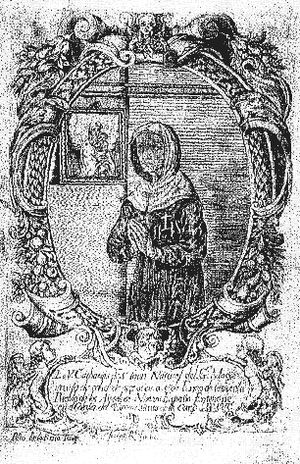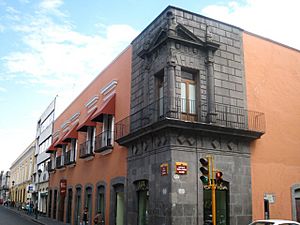Catarina de San Juan facts for kids
Catarina de San Juan (born around 1607, died January 5, 1688, in Puebla, Mexico) was a woman known as the China Poblana. Legend says she was from a noble family in India. She was brought to Mexico through the Spanish East Indies. Many people believe she inspired the famous China Poblana dress.
After being kidnapped by Portuguese pirates in Cochin, India, she became a Christian and was named Catarina de San Juan. She lived in Puebla de Zaragoza, Mexico, where she was a slave, got married, and later became a very religious woman. When she died, Catarina de San Juan was buried in the church of the Jesuits in Puebla. This place is now often called the Tumba de la China Poblana (Tomb of the China Poblana).
Her Story
Most of what we know about Catarina de San Juan comes from books written in the 1600s. These include a speech given at her funeral and two books by priests who knew her. One of these priests, Alonso Ramos, wrote a very long story about her life.
These old stories about her life are quite amazing, and some parts might not be entirely true. Today, experts study these texts to understand how people in the past wrote about holy figures.
Her Journey to Mexico
According to these old writings, a young Indian woman named Mirra was kidnapped by Portuguese pirates. They took her to Cochin, a city in southern India. There, she escaped and found safety in a Jesuit mission. She became a Christian and was given the name Catarina de San Juan.
Later, Mirra was taken to Manila in the Philippines. A merchant bought her as a slave and planned to take her to Mexico to be a servant for the viceroy (a ruler representing the king). But when they arrived in Acapulco, Mexico, the merchant sold her to a man named Miguel de Sosa in Puebla instead. He sold her for much more money than the viceroy had offered.
The China Poblana Dress
Catarina de San Juan, or Mirra, dressed in the style of her home country, India. She wore a sari, which is a long piece of cloth wrapped around the body. She might have also worn a blouse and a skirt, similar to a Langa Voni. It is thought that her unique way of dressing inspired the famous china dress that is now a symbol of Mexican culture.
A few years after she arrived in Mexico, Miguel de Sosa, her owner, passed away. In his will, he gave Catarina her freedom. She then went to live near a convent, where people said she began to have special visions of the Virgin Mary and Baby Jesus.
Catarina de San Juan died on January 5, 1688, when she was 82 years old. For a short time, people in Puebla thought of her as a saint. However, in 1691, church authorities stopped public worship of her. Today, the old Jesuit church in Puebla is still known as La Tumba de la China Poblana because Catarina de San Juan's remains are buried there.
See also
 In Spanish: Catharina de San Joan para niños
In Spanish: Catharina de San Joan para niños




